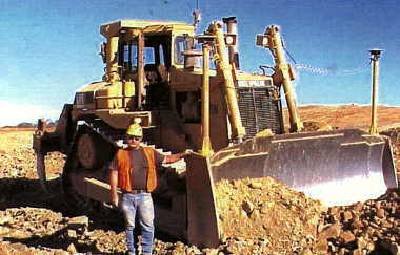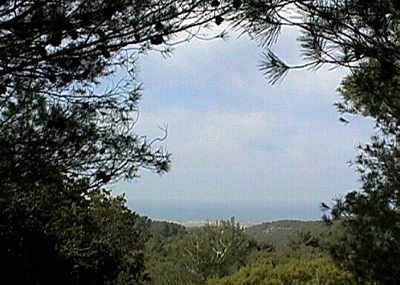 Kiewit Pacific uses SiteVision GIS Grade Control System to dramatically increase dozer productivity over hilly terrain without stakes.
Kiewit Pacific uses SiteVision GIS Grade Control System to dramatically increase dozer productivity over hilly terrain without stakes.
When preparing a site for construction, faster is better The faster the area is graded correctly and the foundations are set, the greater the savings for the excavator and the builder The El Dorado Hills project site, a residential community in Northern California, is where Kiewit Pacific became convinced of this kind of payback from Global Positioning System (GPS) technology for machine guidance in construction The productivity enhancement of Trimble’s SiteVision GPS Grade Control System was apparent on this large development of 300 building foundation pads, nearly eight miles of streets and 2 8 million cubic yards of rock and earth. Laying Out Building Pads
According to Dale Weldy, finish grade foreman, “On the flat pads, production was tremendous.” Before the use of GPS, they were able to make six pads per day. SiteVision GPS on a single D9N dozer roughly doubled their performance. There was even one day where 15 pads were completed.
The operator views design plans, grades and alignments on a rugged, color screen. Machine position is displayed on a plan view map and ongrade lightbars indicate how much vertical correction is required to reach the grade of the design surface.
Pads were built using nothing more than a D9 dozer equipped with SiteVision GPS, all without checkers or stakes. When operator Bob Alto first looked at the area, there were no stakes at all, but he just went to work Using GPS and the site quickly started to take shape. “I had no idea what that area was supposed to look like,” Alto said, “but we built it with GPS ill nothing flats That really convinced me.”
SiteVision GPS installation SiteVision GPS installation from the dozer cabin. Note the GPS trasnsponder outside on the blade tip and vertical light bars either side of the display in the cab.
 “On these pads, GPS worked so well that the dozer operator has done some of my surveying for me,” foreman Weldy confessed. “When the dozer operator saw that I was looking for a corner hub, he waved me out of the way. Then he pulled his machine in, put the corner bit on the grade and signaled me it was about 0.6 foot below that point. I took a shovel and dug right down to it. When I measured from the surface to the top of the hub, it was about 0.61 foot! That was truly impressive.”
“On these pads, GPS worked so well that the dozer operator has done some of my surveying for me,” foreman Weldy confessed. “When the dozer operator saw that I was looking for a corner hub, he waved me out of the way. Then he pulled his machine in, put the corner bit on the grade and signaled me it was about 0.6 foot below that point. I took a shovel and dug right down to it. When I measured from the surface to the top of the hub, it was about 0.61 foot! That was truly impressive.”
Since the El Dorado Hills site is on a ridge, it is by no means a simple, flat job and not easily suited for laser guidance. “I think we had only seven pads that all fell into the same alignment for using laser guidance,” dozer operator Alto noted. “GPS can go through those pads so fast it would make your head spin! Some of the pads that I built, the ones that were pie shaped with a common hinge point, would have been tough to build with stakes. It would have taken two days to do one using stakes and a grade checker. I finished three in a day using SiteVision GPS with no stakes.”
More Than One Machine
Personnel at Kiewit recognized that additional units would improve conditions on the site. As Weldy remarked, “We really needed SiteVision GPS on a D10 in addition to the one on the D9. We could have saved three days if a D10 had GPS guidance to bust loose all that rock and shove it out to about two feet of grade.” Project superintendent, Bo Diaz agreed, “Knowing what I know now, I would use two systems, having one on the D10 to rough things in and have the D9 follow right behind to finish. We could really kick tail with that setup. We could plan both machines tightly and keep them producing full time.” Then he added, “With GPS on a compactor, the operator could get it right without rework. Now, we have to wait for the surveyor to come back, lay out the overbuild, then rework it with either a blade or the dozer. I think the compactor could do it the first time as we are filling.”
The Bottom Line
“In terms of survey cost alone, we actually save between $600 and $700 per day,” according to Diaz. “If you only knew how much I spent just on pioneering a slope on this site. If I had the dozer equipped with GPS, I would easily have saved the cost of the SiteVision.” General superintendent Brian Smith affirmed, “Not only is there clear savings, but we have received tremendous support from Trimble. They have made GPS very easy to use.” With the proof at El Dorado Hills, Kiewit’s next project will use Trimble machine guidance on another residential development in Northern California.







